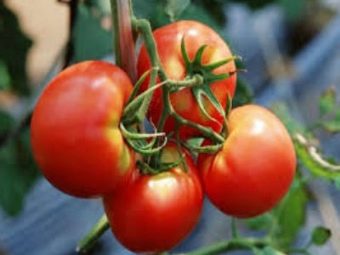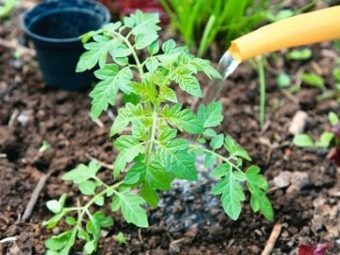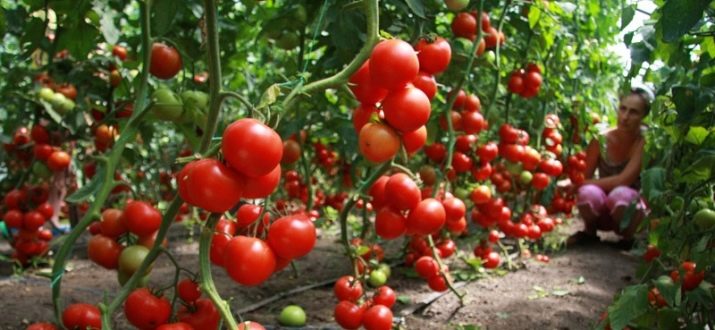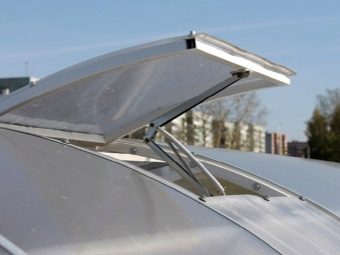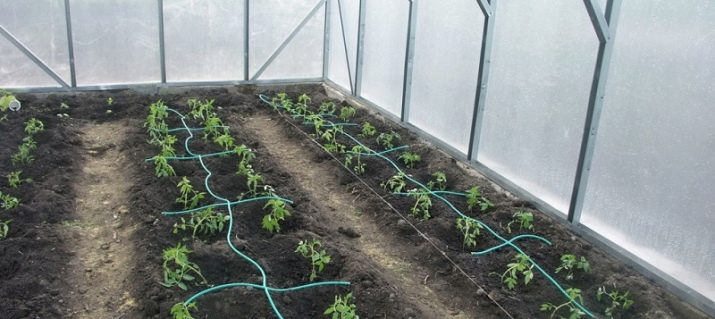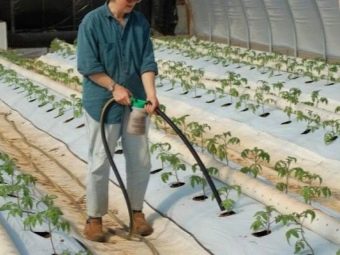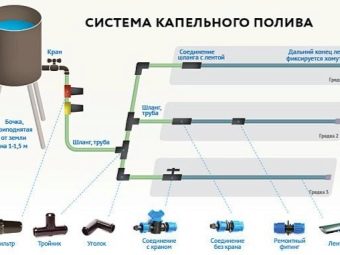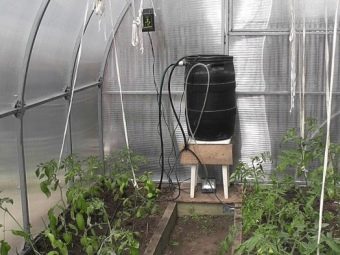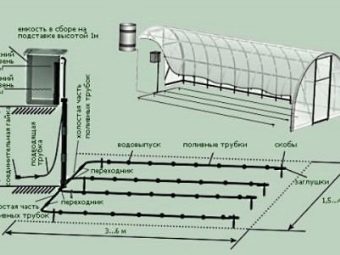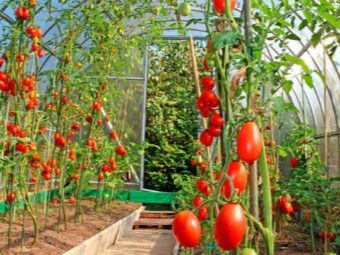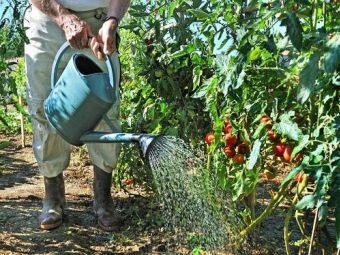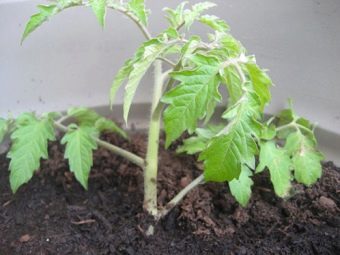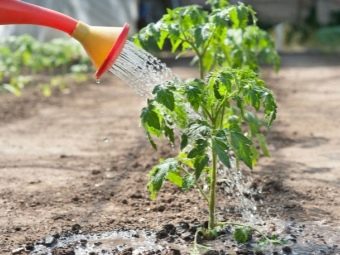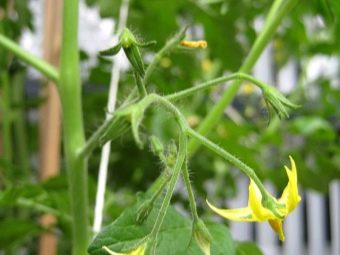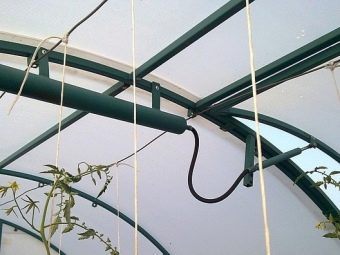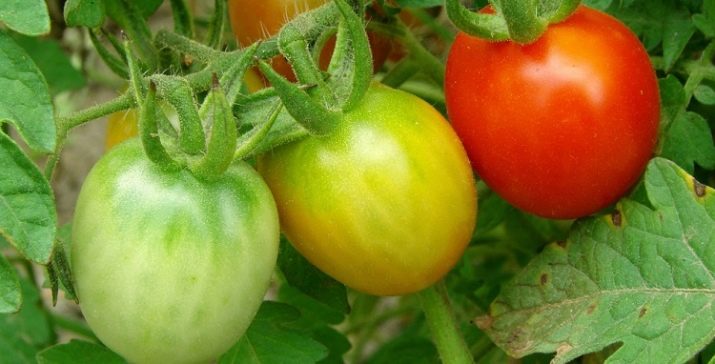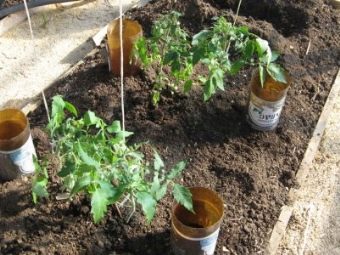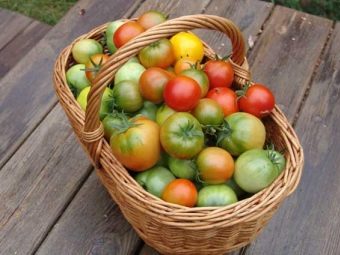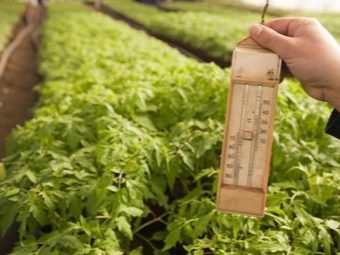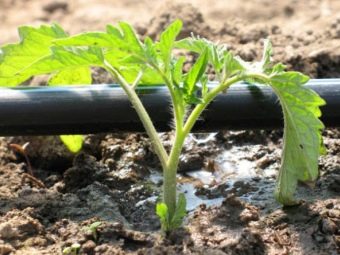How to water the tomatoes in the greenhouse?
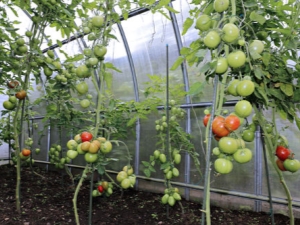
You can grow vegetables in different conditions, and everyone chooses the option that is most convenient for him. If it is not possible to plant tomatoes in an open garden, and there is little space for a balcony to get a full harvest, the construction of a greenhouse is the best choice.
The conditions of such a construction are significantly different from the natural environment of plants, because it is important to know the peculiarities of growing this crop and the subtleties of its irrigation.
Features of the microclimate
Tomatoes are a relatively demanding crop that, under natural conditions, gets everything it needs. But even for this vegetable it is necessary to create an optimal microclimate. It is especially important that the air in the greenhouse is dry and the soil is wet, otherwise the plant starts to develop incorrectly and may begin to ache.
The usual humidity indicators in the summer period range from 60 to 80%, and on particularly hot days they can drop to 40%. If it rains suddenly in the hot summer, then the humidity of the air rises sharply to 90%, while the air temperature does not fall below 30 degrees Celsius.
As for the greenhouse, there are no such significant differences in it, although the external conditions indirectly still affect the development of plants. It is important to air the room in time and provide the plants with the necessary amount of water. Small watering of tomatoes will lead to the slow development of seedlings and small fruits, while excessive moisture will cause root rot and other problems.
You can often see signs of damage in a plant, but not everyone can understand their cause. At the first appearance changes, it is important to take urgent measures to eliminate a possible problem. It is desirable to have in the greenhouse devices that show the level of humidity, it will significantly facilitate the installation of an optimal microclimate. Water the plants need in a timely manner. It is recommended to bring water under a bush when the ground has dried up, but has not hardened.
It is best to use a small amount of moisture so that it absorbs faster into the soil, this will allow the plant to grow and grow faster.
The norms of soil moisture and air
For growing tomatoes in the greenhouse, they consider the relative humidity of 90% for soil and 50% for air to be optimal. In this ratio, the soil gets enough nutrition to grow and develop the bush. But it is the wet environment that causes the appearance of all fungal diseases that lead to the defeat of the plant and its subsequent death.
To obtain the required moisture indicators, it is important to know how to carry out irrigation measures:
- The introduction of water under the bush is carried out no more than twice a week, depending on temperature indicators and air humidity.
- Each bush should have about five liters of water.
- The process of watering is carried out directly under the root of the plant, water should not fall on the green part.
- The best time for the procedure is morning and evening, at this time the bushes are watered not only in the greenhouse, but also in the open field.
- For watering is to use water at room temperature, but not above 24 degrees. Low temperatures adversely affect the normal growth and development of tomatoes.
In case of increase in humidity it is necessary to reduce it, for this you can ventilate the room or use a heater if it is cold outside. It is necessary to ensure that there is an optimum level of humidity in the greenhouse at night, otherwise dew will fall in the morning, which will further increase these figures. Normal conditions help the plants to grow properly, prevent the development of diseases and provide an opportunity to get a good harvest.
If the cultivation of tomatoes occurs in the winter, then without the use of heating devices is necessary. The best option to reduce the level of humidity would be to use airing along with heating, which will keep the air at the right temperature.
Soil moistening occurs with the help of a drip irrigation system. You can check the humidity with a hygrometer and an Assman psychometer.
Ways to Organize
In order to bring water under each bush, there are several different options that require the availability of certain means and equipment. Three methods of watering tomatoes are considered the most popular:
- manual;
- drip;
- auto.
To understand what is better and what is less effective, it is worth considering them in more detail.
Manual
You can use this technique if the greenhouse is small and you need to water only a couple of bushes. For the distribution of moisture can be used watering cans, hoses and similar devices that make it possible to pour water at the root, and not on top, on the leaves. If a hose is used, water is often delivered from the well, which makes it very cold, and this harms the plant. In addition, there is another significant disadvantage, which is that it is very difficult to understand how much moisture was introduced under the bush.
For manual watering is best to use a watering can. You can calculate the right amount of water, in addition, it is possible to defend it before use and reheat. To always have a resource for watering, you must have a special barrel, which will be next. It is important to always close it so that additional moisture does not get into the air, as this will affect the microclimate in the greenhouse.
The amount of watering can be any, it depends on the number of bushes that need to be watered at a time. Too much equipment should not be used, it is difficult to carry, it is not easy to raise and lower, and there is always a chance to shed too much, which can affect the humidity level of this demanding room.
Drip
The use of drip irrigation is effective when the dimensions of the greenhouse are large enough and it is difficult to manually bypass all the bushes for their watering. In addition, this method saves time and, most importantly, the water itself. Using the drip method, a very small amount of water is introduced into the soil, but the watering is stable and constant.
In addition, this method has a number of advantages:
- water drops fall under the root of tomatoes, which reduces evaporation and does not change the humidity in the room;
- there is no risk of getting on the top of the bush and damaging it;
- the watering process is carried out at any time when it is most convenient;
- the soil remains clean, it is not washed out from under the bush, it does not silt.
To organize drip irrigation in the greenhouse for tomatoes, you need to hold a special system of pipes to each bush. Now you can buy a ready-made version in stores or make it yourself. In addition to simple watering, for plant growth, it is recommended to additionally fertilize when needed.
If the cost of arranging the system is too high, you can do this watering from scrap materials, for which a capacity of 5 liters is selected, in which small holes are made, after which it is buried near the bush. After water is poured into it, it will begin to ooze out of the holes, ensuring uniform and gradual moistening of the soil near the bush.
Auto
If the greenhouse is used year-round and has large dimensions, it is best to apply a specialized method of irrigation of tomatoes. Due to the presence of special equipment, it is possible to carry out irrigation measures according to the schedule even without the presence of a person inside. You can use special devices that will remotely turn on and off the water.
In order to constantly water the crop, you need to have a reliable source of water. Most often for this purpose they use central water supply, a well or a well, where there is a pump. The most convenient and safe for seedlings will be the use of an additional barrel, which is located inside the heated room.It accumulates water from the source and is gradually heated, which makes it possible to use moisture at a desired temperature for irrigation and not to injure the bushes. Water to the bushes comes through a special drip tape, which is a hose, where holes are initially made at a distance of 10 to 50 cm. A special feature of the technology is the presence of a drop maze system that slows down the water passing through the hose, and the watering process goes slowly.
If desired, you can independently build such a system, but for this you need to deal with all its nuances and features.
Rules of conducting
Watering tomatoes that grow in a polycarbonate greenhouse should be in the correct proportions, taking into account the planting period. At each stage, the bush absorbs a different amount of water, and the frequency of watering may vary. If cultivation goes all year round, then the greenhouse is equipped with appropriate devices that give the plants the right amount of moisture. It should be borne in mind that external conditions affect the humidity of the air in the greenhouse, so at low temperatures it is necessary to use heaters that dry the air.
In the summer, you need to more closely monitor the microclimate in the greenhouse. The temperature outside can vary greatly from cool to very hot, which can affect tomatoes. To properly set the proportions of soil moisture and air, you need to have a hygrometer and monitor the condition of the soil. The frequency of irrigation will also vary depending on the temperature outside the greenhouse. In very hot weather, watering will increase slightly, and in cool it will be reduced to once a week, since the soil will not dry so actively.
In order not to overdo it with the water that will be brought under the bush, it is important to monitor both the appearance of the soil and inspect the plant itself. By the appearance of the bush, you can understand whether there is a lack of moisture, and the fruits can be clearly seen when there is an overabundance. To get a good harvest you need to know the measure.
When planting seedlings
After planting the tomatoes in a new place for the first time you need to pour five liters of water under the bush and leave it for a week or 10 days for rooting. All this time to make additional moisture is not necessary. The available amount of water will be sufficient for the first days of growth, and in the next stages watering will be carried out using another system. About a week need a bush to start active growth. When planting seedlings, it is important not to damage the bush and move it to a new place with a clod of earth in which the roots are located. This procedure helps the plant to settle down faster and begin to grow actively.
If the conditions for growing seeds and greenhouse indicators differ, then the shoots need to be prepared for a new environment, gradually increasing the time spent in the greenhouse. If the germination takes place directly in the greenhouse, then the development of tomatoes will be more rapid. During the whole process of working with culture, it is important to ensure that the humidity standards are exactly within the limits that the tomato requires. In another case, there is a risk of developing diseases or improper growth of plants, which leads to yield loss or deterioration of its qualities.
Active plant growth
As soon as the seedlings are planted and rooted, one of the most important stages begins, which determines what the shrub will be like and what the yield will be. At this time, the root system does not have time to develop as quickly as the upper part of the bush, because it is difficult to pull moisture at the depth of the plant. To facilitate the task, at this time increase the number of watering up to two times a week. Under the bush make no more than three liters of water at a time, which will allow to impregnate a layer of 15-20 cm thick, which is needed for the roots.
If the bushes are actively growing and the earth dries quickly, you can increase the amount of moisture applied under the bush. It is important to monitor the air humidity so that it remains normal all the time.Active watering can cause strong evaporation, because the greenhouse needs to be well ventilated, otherwise the plants will develop worse and start to hurt.
In the period of fruit set
During the flowering of plants they are watered less often, but the land should be well hydrated. At this time, one-time processing of a bush will suffice, for which at least five liters will be needed. When the fruits begin to set, the amount of moisture should be reduced. Such a measure is needed to prevent overwetting the soil and rotting of the roots. After moistening the soil, it is important to ventilate the room to ensure an optimum level of humidity inside the greenhouse. Usually this process takes about an hour. If you stretch or reduce it, it will be difficult to achieve the desired performance.
During this period, plants are very sensitive to the factors that surround them, and the slightest changes in the usual rhythm of life can significantly affect the quantity and quality of the crop. Each of the stages of plant care is important in its own way, any misstep can lead to adverse consequences, and all efforts to grow vegetables will be reduced to zero.
When ripe tomatoes
Another important period is the moment when the tomatoes in the greenhouse begin to ripen. It is important not to miss it and quickly rebuild the irrigation system. A feature of the process at this time is the reduction in the number of procedures and the reduction of water that is applied under the hive. This is important, since an overabundance of moisture will result in cracking of the fruit, which will also affect its taste.
Usually ripening occurs from the lower branches, where tomatoes are the first to begin to change color. At this time, the soil should be moistened once every 12 days, starting from mid-July until the end of the month. At the next stage, the process of clipping is performed, with the upper stem pinching in order to stop the growth of the bush. This is necessary so that the forces of the plant are directed not at the growth of the bush, but at the ripening of the fruits. To avoid condensation or increased humidity, it is recommended to mulch the soil around tomatoes with grass or other options.
During the ripening period of a tomato, it is recommended to stop watering the plants completely so that the fruits gain a good mass, color and taste. This time most often falls on August. If all recommendations have been implemented correctly, then you can collect large, juicy and tasty fruits that were not affected by fungal diseases and were not attacked by pests.
Recommendations
To grow a good crop of tomatoes in the greenhouse, it is better to prepare in advance for this process. Each stage of growth of culture has its own characteristics. To obtain high yields is important:
- create a suitable indoor climate;
- make the right amount of water;
- use fertilizer.
In addition to the choice of varieties and the concept of how to grow seeds, you need to understand the different irrigation systems, which are different for small household greenhouses and large industrial.
The peculiarity of tomatoes is that they do not like a large amount of moisture, but they also endure a deficiency with difficulty. There are certain norms, which are better to adhere to: up to the moment of flowering up to 4 liters per square meter is introduced, and during the flowering period - 12 liters per m2. Watering is carried out no more than once a week with the exception of certain periods, for example, when there is active growth of the bush. It is important to take into account the temperature of the water when watering - it should not be below 22 degrees.
At high humidity inside the greenhouse the pollination process is disturbed; therefore, it is important to monitor this with the help of instruments. You can carry out mechanical pollination, for which the bushes are shaken daily. After pollination is watering and airing the room. The temperature in the greenhouse should not exceed 22 degrees during the day and fall below 16 degrees at night. When flowering begins, it is permissible to raise the temperature by a couple of degrees, but not above +27.
It is most convenient to water the tomatoes in the greenhouse with the help of the installation with drip irrigation, which you can buy and install yourself. It saves water, as it reasonably uses it. The system can be independently switched on and off if necessary. In order for the bushes to grow strong and the fruits develop correctly, fertilizers should be applied at the time of formation of the ovaries. Using the drip irrigation system, you can add the necessary substances to the water, which will simplify the whole process.
Work on growing tomatoes in greenhouse conditions is not easy. Having mastered all the subtleties and nuances, you can successfully grow a wide variety of varieties both for yourself and for sale, while obtaining a good profit, especially in the cold season.
Do not rush to start work, the first thing you need to do is get the necessary knowledge, acquire the necessary equipment, check the readiness of the greenhouse, and then begin practical work with tomato seeds, which, with proper care and watering, will soon yield a harvest.
On how to water the tomatoes in the greenhouse, see the following video.

